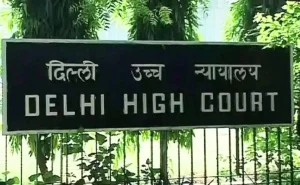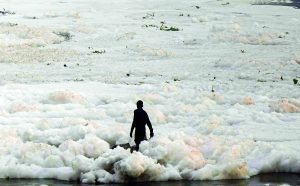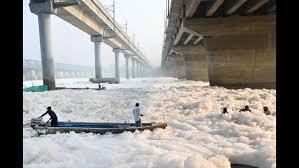New Delhi – The Delhi High Court delivered a scathing Yamuna pollution HC ruling on Thursday, expressing grave concern over the Delhi government’s inability to prevent treated water from mixing with contaminated wastewater before entering the Yamuna River. The court highlighted how this fundamental flaw undermines the entire purpose of sewage treatment plants (STPs) and common effluent treatment plants (CETPs), despite significant public expenditure on water treatment infrastructure.
The Yamuna pollution HC ruling emphasized that current practices defeat the very objectives these treatment facilities were designed to achieve, raising serious questions about resource allocation and environmental protection effectiveness.
Judicial Direction for Comprehensive Pollution Mitigation

A bench comprising Justices Prathiba M Singh and Manmeet PS Arora issued comprehensive directives as part of the Yamuna pollution HC ruling, instructing the chief secretary to implement wide-ranging measures to address the pollution crisis. The court specifically mandated mapping of Delhi’s existing stormwater and sewage drainage systems to understand current infrastructure limitations.
The Yamuna pollution HC ruling called for expert analysis to comprehend how these networks operate in parallel, connect to main drainage systems after treatment, and identify necessary upgrades as part of a comprehensive drainage master plan. This systematic approach reflects the court’s recognition that piecemeal solutions have proven inadequate for addressing the river’s contamination.
Special Committee Exposes Critical Infrastructure Flaws


The Yamuna pollution HC ruling followed extensive review of contrasting reports submitted by a court-constituted special committee and the Delhi government’s own assessment of treatment plant functionality. The special committee, including advocate Vrinda Bhandari and Vivek Tandon, conducted thorough inspections of all STPs and CETPs across Delhi.
The committee’s findings, which influenced the Yamuna pollution HC ruling, revealed systematic problems including treated water mixing with untreated wastewater before entering the Yamuna. Additional issues identified include inappropriate mixing of industrial and domestic waste, significant under-utilization of CETPs, outdated infrastructure, corroded pipelines, and complete absence of live monitoring systems.
The Yamuna pollution HC ruling particularly highlighted non-functional electric, inlet, and outlet meters, indicating comprehensive monitoring system failures across Delhi’s water treatment infrastructure.
Contradictory Government Claims Challenge Court Findings
The Yamuna pollution HC ruling addressed stark contradictions between the special committee’s findings and the Delhi government’s official report claiming satisfactory treatment plant performance. This discrepancy prompted judicial skepticism regarding government transparency and accountability in environmental management.
The court’s Yamuna pollution HC ruling emphasized the need for accurate assessment rather than misleading official reports that obscure the true extent of infrastructure failures and environmental damage.
Judicial Commentary on Resource Wastage and Systemic Failures
The bench’s remarks during the Yamuna pollution HC ruling reflected frustration with ongoing resource misallocation and systemic inefficiencies. The court stated, “The entire purpose of STPs is destroyed if we have the drain water mixed with that treated water… If the drain is still flowing into Yamuna, the entire purpose is finished.”
Also Read: Latest AAP BJP Durga Puja Controversy Erupts Over PM Modi’s Prayer Request
The Yamuna pollution HC ruling questioned why contracts continue being awarded without proper ground-level assessment, noting the massive expenditure involved. The court emphasized that “crores being spent—it’s just not making sense,” highlighting the disconnect between financial investment and environmental outcomes.
Comprehensive Infrastructure Redesign Requirements


The Yamuna pollution HC ruling stressed the need for fundamental infrastructure redesign, with the court stating that “the situation demands going back to the drawing board for the whole of Delhi.” This comprehensive approach requires proper mapping of stormwater and sewage drainage systems to ensure effective pollution control.
The Yamuna pollution HC ruling mandated detailed assessment of how parallel networks connect to main drainage systems after treatment, ensuring that infrastructure upgrades address root causes rather than symptoms of pollution problems.
Industrial Monitoring and Compliance Directives


As part of the Yamuna pollution HC ruling, the Delhi Pollution Control Committee (DPCC) received specific instructions to prepare comprehensive charts of all industrial areas. These charts must specify regular monitoring measures, identify factories with independent treatment plants, and assess waste treatment effectiveness.
The Yamuna pollution HC ruling emphasized systematic industrial monitoring as crucial for preventing contamination from mixing industrial and domestic waste streams, ensuring comprehensive pollution control across all sectors.
Non-Adversarial Approach to Problem Resolution
The court’s Yamuna pollution HC ruling emphasized that without assigning blame at the current stage, comprehensive efforts are essential for effective Yamuna pollution control. This approach focuses on systemic solutions rather than punitive measures, encouraging collaborative problem-solving between government agencies and judicial oversight.
The Yamuna pollution HC ruling demonstrates judicial commitment to environmental protection through constructive engagement rather than adversarial proceedings, prioritizing pollution reduction over institutional conflicts.
Long-Term Environmental Protection Strategy
The comprehensive directives in the Yamuna pollution HC ruling establish framework for long-term environmental protection extending beyond immediate pollution control measures. The court’s emphasis on expert analysis, infrastructure mapping, and systematic monitoring creates foundation for sustainable water quality improvement.
This strategic approach ensures that future infrastructure investments align with environmental protection objectives, preventing repetition of current systemic failures that have compromised Yamuna River water quality despite substantial public expenditure on treatment facilities.

